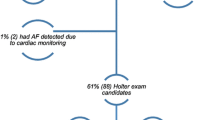Abstract
Background
Atrial fibrillation and flutter are well-known causes of stroke. Whether other atrial arrhythmias categorized as paroxysmal supraventricular tachycardia (PSVT) are associated with stroke is less clear. We aimed to evaluate the association of PSVT with ischemic and embolic stroke and its impact on short-term outcomes in hospitalized stroke patients.
Methods
National Inpatient Sample database of the USA was used to assess the association of PSVT with ischemic stroke. Atrial fibrillation and flutter were excluded to minimize the confounding effects. The association of PSVT with stroke was evaluated using univariate and multivariate analysis. Subgroup analyses by gender, age, and stroke type were also performed.
Results
PSVT was associated with increased odds of overall ischemic stroke in univariate [OR 1.18 (95% CI 1.09–1.27) p < 0.001] analysis. No such association was observed in multivariate analysis (OR 1.06 (95% CI 0.98–1.14) p = 0.1) or with subgroup analysis by gender and age. However, PSVT was associated with embolic stroke in both univariate (OR 2.01 (95%CI 1.67–2.43, p < 0.001) and multivariate analysis (OR 1.7 (95%CI 1.4–2.14) p < 0.001) as well as in subgroup analyses by gender and age. Furthermore, the presence of PSVT was associated with increased mortality in embolic stroke (OR 4.11, CI 2.29 to 7.39, p < 0.001) and increased total hospital cost and length of hospital stay in all stroke types.
Conclusions
PSVT is independently associated with higher prevalence of embolic stroke but not with overall ischemic stroke. Patients with embolic stroke in the presence of PSVT have worse in-hospital outcomes with increased mortality.



Similar content being viewed by others
Abbreviations
- PSVT:
-
Paroxysmal supraventricular tachycardia
- AF:
-
Atrial fibrillation
- AFl:
-
Atrial flutter
- CI:
-
Confidence interval
- OR:
-
Odds ratio
- NIS:
-
National Inpatient Sample
- ICD:
-
International Classification of Disease
References
Feigin VL, Forouzanfar MH, Krishnamurthi R, et al. Global and regional burden of stroke during 1990-2010: findings from the Global Burden of Disease Study 2010. Lancet Lond Engl. 2014;383:245–54.
Demaerschalk BM, Hwang H-M, Leung G. US cost burden of ischemic stroke: a systematic literature review. Am J Manag Care. 2010;16:525–33.
Ferro JM. Cardioembolic stroke: an update. Lancet Neurol. 2003;2:177–88.
Binici Z, Intzilakis T, Nielsen OW, et al. Excessive supraventricular ectopic activity and increased risk of atrial fibrillation and stroke. Circulation. 2010;121:1904–11.
Go AS, Hlatky MA, Liu TI, et al. Contemporary Burden and Correlates of Symptomatic Paroxysmal Supraventricular Tachycardia. J Am Heart Assoc 2018; 7.
Miyamoto KJ, Tsuchihashi K, Uno K, Shimoshige SY, Yoshioka N, Doi A, et al. Studies on the prevalence of complicated atrial arrhythmias, flutter, and fibrillation in patients with reciprocating supraventricular tachycardia before and after successful catheter ablation. Pacing Clin Electrophysiol. 2001;24:969–78.
Kamel H, Elkind MSV, Bhave PD, Navi BB, Okin PM, Iadecola C, et al. Paroxysmal supraventricular tachycardia and the risk of ischemic stroke. Stroke. 2013;44:1550–4.
Chiang J-K, Kao H-H, Kao Y-H. Association of paroxysmal supraventricular tachycardia with ischemic stroke: a national case-control study. J Stroke Cerebrovasc Dis. 2017;26:1493–9.
Anon. HCUP-US NIS Overview. Available at: https://www.hcup-us.ahrq.gov/nisoverview.jsp. Accessed June 9, 2018.
Goldstein LB. Accuracy of ICD-9-CM coding for the identification of patients with acute ischemic stroke: effect of modifier codes. Stroke. 1998;29:1602–4.
Alhadramy O, Jeerakathil TJ, Majumdar SR, Najjar E, Choy J, Saqqur M. Prevalence and predictors of paroxysmal atrial fibrillation on Holter monitor in patients with stroke or transient ischemic attack. Stroke. 2010;41:2596–600.
Khachab H, Brembilla-Perrot B. Prevalence of atrial fibrillation in patients with history of paroxysmal supraventricular tachycardia. Int J Cardiol. 2013;166:221–4.
Hamer ME, Wilkinson WE, Clair WK, Page RL, McCarthy E, Pritchett EL. Incidence of symptomatic atrial fibrillation in patients with paroxysmal supraventricular tachycardia. J Am Coll Cardiol. 1995;25:984–8.
Healey JS, Connolly SJ, Gold MR, Israel CW, van Gelder I, Capucci A, et al. Subclinical atrial fibrillation and the risk of stroke. N Engl J Med. 2012;366:120–9.
Meiltz A, Zimmermann M. Atrioventricular nodal reentrant tachycardia in the elderly: efficacy and safety of radiofrequency catheter ablation. Pacing Clin Electrophysiol. 2007;30(Suppl 1):S103–7.
Kohsaka S, Sciacca RR, Sugioka K, Sacco RL, Homma S, di Tullio MR. Electrocardiographic left atrial abnormalities and risk of ischemic stroke. Stroke. 2005;36:2481–3.
Katoh S, Honda S, Watanabe T, Suzuki S, Ishino M, Kitahara T, et al. Atrial endothelial impairment through Toll-like receptor 4 signaling causes atrial thrombogenesis. Heart Vessel. 2014;29:263–72.
Kamel H, Okin PM, Longstreth WT, et al. Atrial cardiopathy: a broadened concept of left atrial thromboembolism beyond atrial fibrillation. Futur Cardiol. 2015;11:323–31.
Sanna T, Diener H-C, Passman RS, et al. Cryptogenic stroke and underlying atrial fibrillation. N Engl J Med. 2014;370:2478–86.
Alkhouli M, Alqahtani F, Aljohani S, Alvi M, Holmes DR. Burden of Atrial Fibrillation-Associated Ischemic Stroke in the United States. JACC Clin Electrophysiol. 2018;4:618–25.
Bybee KA, Prasad A. Stress-related cardiomyopathy syndromes. Circulation. 2008;118:397–409.
Abboud H, Berroir S, Labreuche J, Orjuela K, Amarenco P, GENIC Investigators. Insular involvement in brain infarction increases risk for cardiac arrhythmia and death. Ann Neurol. 2006;59:691–9.
Author information
Authors and Affiliations
Corresponding author
Ethics declarations
Conflict of interest
The authors declare that they have no conflict of interest.
Additional information
Publisher’s note
Springer Nature remains neutral with regard to jurisdictional claims in published maps and institutional affiliations.
Electronic supplementary material
ESM 1
Supplementary Appendix: ICD-9 codes used for identification of study population (DOCX 12 kb)
Rights and permissions
About this article
Cite this article
Sharma, S.P., Kondur, A., Gopinathannair, R. et al. Is paroxysmal supraventricular tachycardia truly benign? Insightful association between PSVT and stroke from a National Inpatient Database Study. J Interv Card Electrophysiol 59, 35–41 (2020). https://doi.org/10.1007/s10840-019-00651-7
Received:
Accepted:
Published:
Issue Date:
DOI: https://doi.org/10.1007/s10840-019-00651-7




